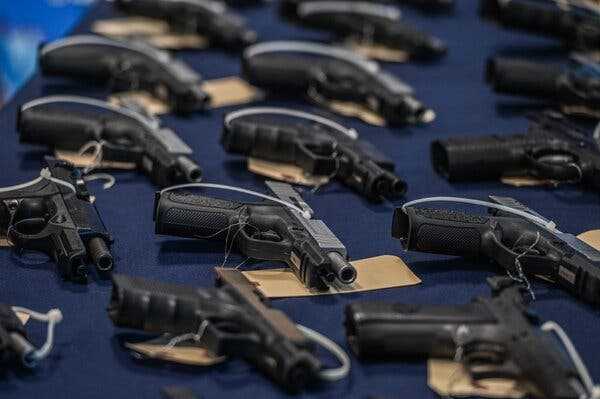The Bureau of Alcohol, Tobacco and Firearms created a statistical portrait that law enforcement agencies can use to address new threats, which include untraceable “ghost guns.”
-
Send any friend a story
As a subscriber, you have “>10 gift articles to give each month. Anyone can read what you share.
Give this articleGive this articleGive this article

Guns seized by federal law enforcement actions displayed during a news conference in Miami last year. The gun lobby has sought to limit public access to information about firearms.
WASHINGTON — About two million guns linked to crimes were recovered by law enforcement officials around the country from 2017 to 2021 — many of them semiautomatic pistols modeled on Glock 9-millimeter handguns, according to the most comprehensive national accounting of crime guns in decades.
The Bureau of Alcohol, Tobacco, Firearms and Explosives analyzed data in a federal gun tracing system to create a statistical portrait that law enforcement agencies can use to address new threats, such as the increased use of untraceable homemade firearms known as “ghost guns.”
The report, the second volume of a three-part study, largely reinforced well-known patterns, including the importance of quickly investigating weapons thefts or illegal purchases to keep them from being used in crimes and the fact that the people most likely to use guns in crimes are men under the age of 40.
The number of requests entered into an A.T.F. tracing system, which uses serial numbers to match recovered guns with the purchase records of licensed dealers, has increased in line with an overall rise in crime over the past few years — from about 338,000 such requests in 2017 to 460,000 in 2021.
But the study has a political significance beyond the numbers: Attorney General Merrick B. Garland authorized the project in mid-2021 as a way to counter the gun lobby’s effort to limit public access to such information, seeking to offer timely and accurate data on guns used in crimes.
Gun Violence in America
- Fighting for Gun Safety: A 2011 mass shooting left Gabrielle Giffords, then a Democratic congresswoman, partly paralyzed and unable to speak fluently. She has since built a powerful advocacy group.
- A Growing Tally: Gun violence is a persistent American problem. A partial list of mass shootings this year offers a glimpse at the scope.
- Gun Control: U.S. gun laws are at the center of heated exchanges between those in favor and against tougher regulations. Here is what to know about that debate.
- Bystanders Become Heroes: Civilians, armed or not, have put their bodies on the line to stop gunmen. But many say it should never have come to that.
“Information is power,” Steven M. Dettelbach, the A.T.F.’s director, said in a statement on Wednesday. “This report provides more information on America’s crime guns than has ever been compiled in a single publication.”
The last similar report was produced in the 1990s, making it difficult to draw long-term historical comparisons.
Even so, several emerging trends were striking.
The use of ghost guns, known as privately manufactured firearms, has exploded in recent years, climbing from about 1,600 from crime scenes in 2017 to nearly 20,000 in 2021 — prompting the A.T.F. to significantly toughen its regulations of homemade weapons.
A particularly worrying development: the rising number of weapons used in crimes that were obtained through multiple purchases at gun shops. That might indicate an increase in so-called straw purchases in which a legal customer uses a clean criminal record to pass federal background checks, only to resell the weapons to criminals unable to lawfully buy guns.
Also notable was the surging popularity of semiautomatic pistols — easy to conceal, fire and toss away — among criminals. Despite the widely publicized use of rifles in mass shootings, those weapons represented only about 12 percent of crime guns recovered. By contrast, 68 percent of the firearms traced to crimes were pistols, with brand-name Glock pistols accounting for about 13 percent of the total.
Those statistics align with reports from local governments. Last month, Everytown for Gun Safety, a gun control group founded by Michael Bloomberg, the former New York City mayor, found that four handgun manufacturers — Glock, Smith & Wesson, Taurus and Ruger — accounted for more than half the crime guns recovered in 31 cities around the country.
The manufacturers and their trade groups have said that they comply with the law and that the vast majority of customers around the country are legally exercising their Second Amendment right to bear arms for self-protection, hunting and recreation.
The report also offered a sobering assessment of what law enforcement officials do not know, documenting wide gaps in the reporting and tracing systems that make it harder to investigate killings, robberies, gun running and other crimes.
Nearly a quarter of guns reported as used in crimes — 439,000 — were untraceable because their paperwork was incomplete, falsified or missing as serial numbers had been obliterated, or for other reasons, the A.T.F. found.
Source: nytimes.com



